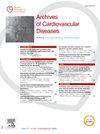CMR在巴洛氏病中定义左室基底的功能与解剖方法:量化二尖瓣反流的最佳方法是什么?
IF 2.2
3区 医学
Q2 CARDIAC & CARDIOVASCULAR SYSTEMS
引用次数: 0
摘要
在双瓣二尖瓣脱垂(BMVP)中,基于多普勒超声心动图的二尖瓣反流(MR)严重程度量化技术可能不准确,而心脏磁共振(CMR)的容量评估可能更好地反映容量过载。然而,在存在严重脱垂的情况下,测量左心室收缩末期容积(LVESV)的最佳方法尚不清楚。实际上,在收缩期末期,左室基底可以在心室环(功能方法)或小叶水平(解剖学方法)确定。目的比较两种方法及其与术后心脏重构的关系。方法连续患者在基线时进行超声心动图和/或CMR评估,并要求患者在12个月内(当进行手术修复/置换时)重复CMR。仅分析BMVP患者。采用直接定量方法计算二尖瓣返流容积,分别在环或小叶处测量LVESV,并比较各自与术后左室舒张末期容积绝对减少的相关性(图1、图2)。结果在33例BMVP患者中,14例最终接受了手术,11例术前和术后均有CMR。功能组术前LVEF为59.5±5.6%,解剖组术前LVEF为49.1±8.2%。与解剖组相比,功能组二尖瓣返流体积(MRV)高估23.8±14.5 ml(图1)。只有解剖测量的MRV与术后左室重构有显著相关性(r = 0.65, P <;0.05)(图2)。结论与功能方法相比,解剖方法能更好地预测术后左室重构。解剖方法可能是量化BMVP CMR MR严重程度的首选方法,但这些初步结果需要在更大的队列中得到证实。本文章由计算机程序翻译,如有差异,请以英文原文为准。
Functional versus anatomical method for defining the LV base by CMR in Barlow's disease: What is the best approach for quantifying mitral regurgitation?
Background
In bileaflet mitral valve prolapse (BMVP), Doppler-based echocardiographic quantification techniques of mitral regurgitation (MR) severity may be inaccurate and volumetric assessment by Cardiac Magnetic Resonance (CMR), might better reflect volume overload. However, the optimal method for measuring Left Ventricular End Systolic Volume (LVESV) in the presence of severe prolapse is unknown. Indeed, at end-systole, the LV base can either be defined at the annulus (functional method) or at the leaflets’ level (anatomical method).
Objectives
We aimed to compare these two methods and their association with post-surgical cardiac remodeling.
Methods
Consecutive patients referred for evaluation of MR were assessed with echocardiography and/or CMR at baseline and patients were invited to repeat CMR within 12 months of surgical repair/replacement (when performed). Only patients with BMVP were analyzed. Mitral regurgitant volume was calculated using direct quantitative method with LVESV measured either at the annulus or at the leaflets, and the respective correlations with the absolute reduction in LV end-diastolic volume after surgery were compared (Figure 1, Figure 2).
Results
Among 33 BMVP patients included, 14 eventually underwent surgery and 11 had both pre- and post-operative CMR. Pre-operative LVEF was 59.5 ± 5.6% in the functional group versus 49.1 ± 8.2% in the anatomical group. The mitral Regurgitant Volume (MRV) was overestimated by 23.8 ± 14.5 ml in the functional compared to the anatomical group (Fig. 1). Only the anatomical measure of the MRV was significantly correlated with post-operative left ventricular remodeling (r = 0.65, P < 0.05) (Fig. 2).
Conclusion
Our results indicate a better ability to predict post-surgical LV remodeling with the anatomical compared to the functional method in BMVP. The anatomical method may be the method of choice for the quantification of MR severity with CMR in BMVP but these preliminary results need to be confirmed in a larger cohort.
求助全文
通过发布文献求助,成功后即可免费获取论文全文。
去求助
来源期刊

Archives of Cardiovascular Diseases
医学-心血管系统
CiteScore
4.40
自引率
6.70%
发文量
87
审稿时长
34 days
期刊介绍:
The Journal publishes original peer-reviewed clinical and research articles, epidemiological studies, new methodological clinical approaches, review articles and editorials. Topics covered include coronary artery and valve diseases, interventional and pediatric cardiology, cardiovascular surgery, cardiomyopathy and heart failure, arrhythmias and stimulation, cardiovascular imaging, vascular medicine and hypertension, epidemiology and risk factors, and large multicenter studies. Archives of Cardiovascular Diseases also publishes abstracts of papers presented at the annual sessions of the Journées Européennes de la Société Française de Cardiologie and the guidelines edited by the French Society of Cardiology.
 求助内容:
求助内容: 应助结果提醒方式:
应助结果提醒方式:


